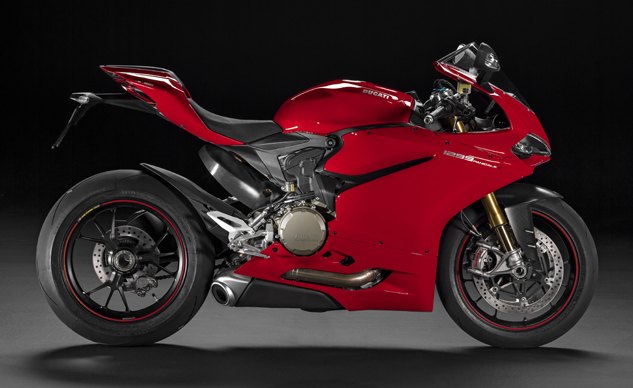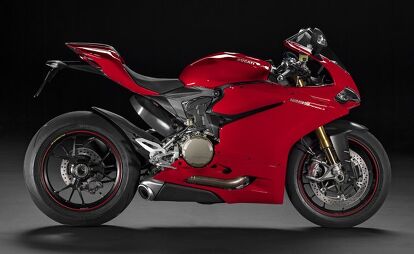2014 EICMA: 2015 Ducati 1299 Panigale Preview

Bigger cylinders and advanced electronics highlight Ducati's flagship sportbike
Big news coming out of the Ducati camp today at EICMA 2014: Bologna’s flagship sportbike is indeed increasing in displacement – introducing the Ducati 1299 Panigale. Rumors about a bigger Panigale had been spreading among the industry throughout the year, with Portland, Oregon dealer, Motocorsa, fanning the flames with this picture taken at Ducati’s U.S. dealer meeting. With the secret out of the bag, let’s take a closer look at the 1299 Panigale.
With a highly oversquare bore/stroke measurement of 112 x 60.8mm, it was believed Ducati would increase the Superquadro’s stroke to achieve the bigger engine. Surprisingly, Ducati left the stroke alone, choosing instead to increase bore size even more – to 116mm – yielding a displacement of 1285cc. Of course, with a bigger engine comes more power, and Ducati says the 1299 will break the double ton, pumping out 205 hp and 106.7 lb-ft of torque (at the crank) – 10 horses more than before and nearly 9 lb-ft greater, too.
However, the last time we had a 1199 Panigale on the dyno, during our 2012 European Literbike Shootout, the Ducati made 162 hp and 81.7 lb-ft. to the wheel. Extrapolating the roughly 15% driveline loss to the 1299, we expect about 175 hp and 91 lb-ft to reach the ground – serious power indeed. Ducati also says wet weight for the 1299 will be 420 lbs.
In typical Ducati fashion, that power can be harnessed in a variety of ways thanks to a further refined electronics package compared to its predecessor. The three ride modes (Race, Sport, Wet) haven’t gone anywhere, and neither has Ducati Traction Control (DTC), Ducati Wheelie Control (DWC) and Engine Brake Control (EBC), all of which feature an automatic calibration system should the owner change final drive gearing or use tires with a different profile than the standard 120/70-17 front, 200/55-17 rear Pirelli Diablo Supercorsa SP.
Besides the bigger engine, the next big breakthrough on the 1299 Panigale is the addition of Cornering ABS, by Bosch, made possible with the addition of what Ducati calls an Inertial Measurement Unit (IMU). Similar in concept to the system first seen on KTM’s 1190 Adventure, Cornering ABS uses sensors to measure lean angle, pitch, braking force and other parameters. In the event of, say, an emergency stop while leaned over, it will distribute braking force between the two wheels and reduce the tendency for the bike to stand while braking.
This allows riders to brake as hard as they dare while leaned over with a significantly reduced chance of tucking the front, crashing, or even leaving your lane. The system has received rave reviews by those who have tried it on the KTM, with the general consensus being that it virtually eliminates any chance of falling over while committing the (normally) crucial error of grabbing a handful mid-corner.
Of course, calling it crashproof would be a mistake since, as yet, man has not found a way to break the laws of physics. That said, the folks at Bosch, who designed the system, have come damn close. Finishing off the electronics package is the return of the Ducati Quick Shift, though now the system works for both upshifts and downshifts, making the clutch only necessary at stops.
On the chassis front, the “frameless” Panigale, which uses the engine as the main stressed member, receives a steeper rake of 24 degrees, compared to the 24.5-degree angle from before. The swingarm pivot is also 4mm lower for improved rear traction. As is to be expected, the 1299 Panigale will come in two versions: the standard and S models, with suspension components being the main difference.
Standard model 1299s come fitted with a fully adjustable Marzocchi 50mm inverted fork and Sachs monoshock. Meanwhile, S model 1299s feature a semi-active Ohlins NIX30 43mm inverted fork with TiN treatment and Ohlins TTX36 shock. Both units are fully adjustable, with compression and rebound circuits adjustable electronically. Ohlins also supplies the semi-active steering damper on S models, while standard models get an analog Marzocchi damper.
S models also stand apart from the standard bikes by way of forged wheels (cast wheels on standard 1299), full LED headlight, carbon fiber front fender, and the addition of thumb and trigger finger buttons to adjust DTC, DWC and EBC on the fly. Standard Panigales are predisposed for the buttons, but aren’t already equipped with them. Lastly, the easily readable TFT instrument display returns on both models, bolstered by the inclusion of a lean angle indicator.
Panigale R
For 2015 the Panigale R is back, dropping the 1199 it had in its name last year. Because World Superbike rules limit Twins to a 1200cc displacement, the 1299 Panigale is ineligible. Instead, Ducati’s homologation racer keeps the previous 1198cc Superquadro engine, but gets a host of upgrades. Both intake and exhaust valves are titanium, as are the connecting rods. Pistons feature two rings and the light crankshaft is balanced using tungsten inserts. Ducati says the Panigale R, like the 1299 version, will achieve 205 hp, but the smaller engine reaches that figure at 11,500 rpm, 1000 revs higher than the 1299. Torque is obviously down slightly from the bigger bike (100.5 lb-ft vs. 106.7 lb-ft), and comes at a higher engine speed (10,250 rpm vs. 8750 rpm).
The R also differs from the 1299s by way of its full Titanium Akrapovic exhaust system and lightweight lithium-ion battery. Ohlins still provides the NIX30 43mm inverted fork and TTX36 shock, but these units are fully mechanical, not semi-active or electronic.
Otherwise, the Panigale R receives the same electronics package as the 1299 Panigale S, including the DTC, DWC, EBC (with the thumb/finger buttons for all three), DQS, ride modes TFT display and Cornering ABS. The R also comes standard with the Ducati Data Analyser (DDA), with GPS and lean angle visualization. All together, Ducati says the Panigale R weighs 406 lbs including “all fluids and fueled to at least 90% of usable tank capacity.” That’s a 14-lb weight reduction compared to the 1299 Panigale, 11 lbs less than the 2014 Panigale R and only 13 lbs heavier than the ultra exclusive 1199 Superleggera.
Pricing information was not made available at press time.

Troy's been riding motorcycles and writing about them since 2006, getting his start at Rider Magazine. From there, he moved to Sport Rider Magazine before finally landing at Motorcycle.com in 2011. A lifelong gearhead who didn't fully immerse himself in motorcycles until his teenage years, Troy's interests have always been in technology, performance, and going fast. Naturally, racing was the perfect avenue to combine all three. Troy has been racing nearly as long as he's been riding and has competed at the AMA national level. He's also won multiple club races throughout the country, culminating in a Utah Sport Bike Association championship in 2011. He has been invited as a guest instructor for the Yamaha Champions Riding School, and when he's not out riding, he's either wrenching on bikes or watching MotoGP.
More by Troy Siahaan



































































Comments
Join the conversation
Well, at least Jay Leno will get to enjoy them!
A freaking IMU on a motorcycle?!? Those things can be awful sensitive to vibration and stuff. And they're freaking expensive! An IMU is one of the things that makes a "smart" weapon smart..... and so expensive! So, do you have to start the bike and then wait several minutes before riding off so the gyros in the IMU can spin up to speed?